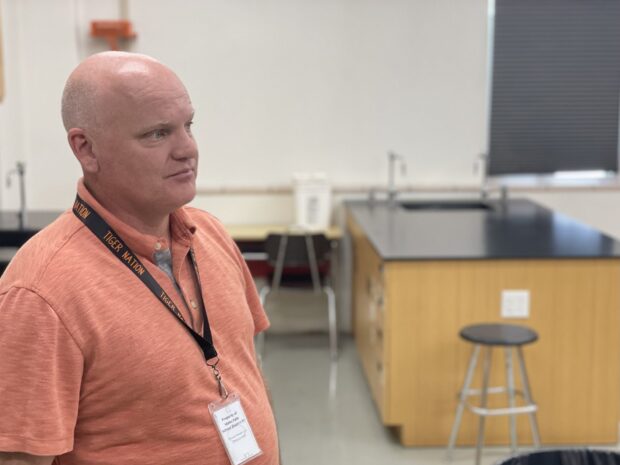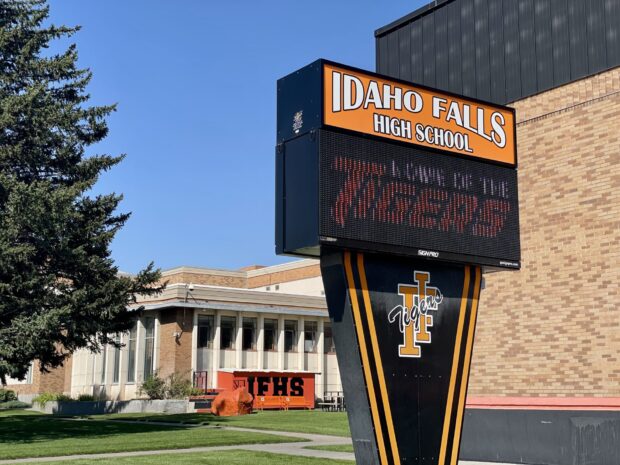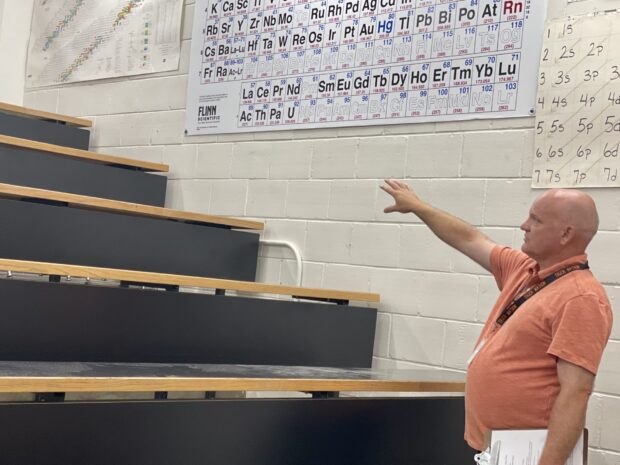IDAHO FALLS — The Idaho Falls School District’s request for $250 million in new and upgraded facilities is “a lot to ask,” trustee Hillary Radcliffe admitted Wednesday.
It’s a state record, in terms of school bond issues.
But it’s also a longtime coming, said Radcliffe, who’s heading up the board’s community outreach efforts for the bond. “The need is there.”
Last month, Radcliffe and other trustees voted unanimously to put the measure on the Nov. 8 ballot — an appeal to local property owners to bankroll construction of a new Idaho Falls High School, two elementary schools and upgrades to Skyline High School.
The request revives the district’s failed attempts in 2017 and 2018 to upgrade its aging schools.
But things are different this time. Two proposed elementary schools and sky-high building costs have pushed the request to taxpayers into unprecedented territory. The new price tag, which more than doubles what the district failed to secure in recent years, has raised eyebrows — and set the stage for pushback.
“I don’t know where to start. (The amount) is just so ridiculous,” said Lisa Keller, spokeswoman for D91 Taxpayers, a local citizens’ group that fought both of the district’s prior requests for upgrades.
But the clock is ticking, and the need for more space is growing, said Idaho Falls High School Principal Chris Powell, who on Wednesday took EdNews on a tour of his school, which is overcrowded by hundreds of students. “We have to do something.”

The price tag for upgrades has more than doubled since 2017
In 2017, Idaho Falls floated a bond to rebuild Idaho Falls High School and remodel Skyline High School, along with other upgrades.
The price tag then: a cool $110 million.
The measure garnered heated pushback from D91 Taxpayers and failed to meet the two-thirds supermajority of votes needed for a bond issue to pass in Idaho. So trustees whittled the proposal to $82.6 million in 2018, with an optional $13.3 million “tiered” measure to build a $9.8 million performing arts center at Skyline and a $3.5 million “gymatorium” at Idaho Falls High.
With just 58% support — and lingering opposition — the second attempt failed.
Four years and a global pandemic later, Idaho Falls has revived the effort. But needed upgrades, as the district sees them, have only expanded. And costs have only risen, bringing the new measure to levels Idaho has never seen.
Growth projections fuel renewed efforts — and price hike
From 2017 to 2020, the district’s enrollment actually dropped from 10,257 to 10,005 students, state enrollment numbers show. But last year, amid a housing boom, the number jumped back up to 10,092.
And more growth is coming, according to the district’s master facilities plan, which points to a steady increase in single-family housing permits since 2014, at least seven of Idaho Falls’ 18 schools expected to be at over 100% capacity in five years, with several parcels of development sitting to the north and south of Idaho Falls.
An aging Idaho Falls High School, which is already operating at 141% capacity, has felt the brunt of recent growth. Last year’s start-of-school enrollment at Idaho Falls High was 1,299. This year’s: 1,414.
Skyline High is operating at 118% capacity, with projected growth expected to bring it to 121% over the next five years, according to the district’s facilities plan.
Add the two proposed elementary schools to ease overcrowding in four of the district’s 12 elementary schools and head-scratching inflation for building materials in recent years, and the price tag of a new measure soars.
Here’s a snapshot of the current measure’s key costs and upgrades:
- $118.8 million for a new 1,800-student, 258,208 square-foot Idaho Falls High School. A similarly sized school would have cost $72.1 million in 2018, according to a cost-summary forecast on the district’s website.
- $71.4 million for remodels and additions at Skyline High School, which would also bring the school to an 1,800-student capacity. In 2017, the same updates would’ve cost around $44.8 million, according to the same cost-summary forecast.
- $53.9 million for two new elementary schools, each equipped for 600-plus students. One school would absorb students in Idaho Falls’ south side. The other would replace Temple View Elementary School on the district’s north side. In 2012 and 2013, the district built four new elementary schools at an average $11.5 million per school.
The summary forecast includes a caveat: costs could be “substantially more” than listed, depending on market changes.

‘It’s just not big enough’
District leaders aren’t the only ones pushing for the measure’s flagship proposal to replace Idaho Falls High.
Sixty-four percent of 2,989 respondents to a recent district survey support rebuilding the school, survey results show, while 36% support renovating the school at its current location. Eighty percent of respondents support relocating a new Idaho Falls High School to a district-owned site at 49th Street and Holmes Avenue, if the school is rebuilt.
Seventy-four percent of survey respondents supported major improvements at Skyline High School, 78% supported construction of a new elementary school on the district’s south side and 70% supported building one on the district’s north side. Go here for a full rundown of survey results.
For Powell, the issue at Idaho Falls boils down to a lack of space.
“It’s just not big enough,” he said.
Idaho Falls isn’t using the hallways or teachers’ lounge for instructional space like this Middleton school, Powell acknowledged, but he pointed to multiple areas of concern:
- Classroom, bathroom and extracurricular spaces are tight for the school’s 1,400-plus students. A science lab that four teachers must reserve for lab time impacts student instruction by forcing teachers to schedule around each other.
- Four modular units, purchased two years ago, house classrooms in what used to be teacher parking behind the school. A former shop for busing houses classrooms that struggle to keep water from coming in under the doors when it rains. Other classes meet in makeshift classroom space under the football stadium.
- The Idaho Falls Civic Auditorium, which is owned by the city, is attached to the school’s north end. The district uses classroom space behind the auditorium, but the city “wants it back,” said Powell. The auditorium’s restrooms are also on the school’s side, bringing people into the building after school hours during community events. A barricade keeps them in areas around the restrooms, but the arrangement is still a concern for Powell.
- Hallways spaced for smaller enrollments leave students shoulder-to-shoulder at the school’s main passageway near the front office, spurring safety concerns and making hall monitoring a tough task for educators.
For Powell, the arrangements are problematic, but past measures have raised questions about how pressing they actually are.
Community outreach this time around will include tours of the school so patrons can decide for themselves, Radcliffe stressed.

The measure’s potential impact on taxpayers is still unclear
The district is still waiting on county assessments to gauge how much a $250 million measure would impact local taxpayers.
In Idaho, property owners bankroll bond issues through their property taxes. But because market values vary from district to district, some communities can absorb measures better than others, softening the blow for households and businesses.
Districts often provide impact estimates per $100,000 of taxable value. When county numbers are calculated, Idaho Falls spokeswoman Margaret Wimborne said, the district will put up a tool on its website for patrons to see how much they’ll pay if the measure passes.
Idaho law also requires districts to put costs per $100,000 on the ballot.
Still, Keller said the sticker shock is already apparent.
“(The amount) is simply tone deaf,” she said, adding that her group hasn’t met formally to discuss an official position on the measure. But she expects that to happen in the coming months.
Other community members are starting to chime in. Former Idaho Falls city councilman Larry Lyon, who also publicly opposed the district’s prior bonds, echoed Keller’s concerns: “We all want great schools for our children, but this new request is a staggering new tax that I feel has zero chance of passing in November.”
Radcliffe expressed hope: “I think it has a chance.”
